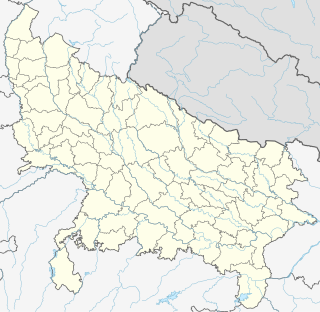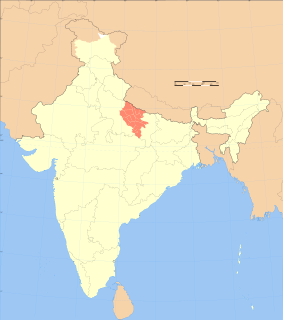
Major-General Robert Clive, 1st Baron Clive,, also known as Clive of India, Commander-in-Chief of British India, was a British officer and privateer who established the military and political supremacy of the East India Company in Bengal. He is credited with securing a large swath of South Asia and the wealth that followed, for the British East India Company. In the process, he also turned himself into a multi-millionaire. Together with Warren Hastings he was one of the key early figures setting in motion what would later become British India. Blocking impending French mastery of India, and eventual British expulsion from the continent, Clive improvised a military expedition that ultimately enabled the East India Company to adopt the French strategy of indirect rule via puppet government. Hired by the company to return a second time to India, Clive conspired to secure the Company's trade interests by overthrowing the locally unpopular heir to the throne of Bengal, the richest state in India, richer than Britain, at the time. Back in England, he used his success to secure an Irish barony, from the then Whig PM, Thomas Pelham-Holles, 1st Duke of Newcastle, and again a seat for himself in Parliament, via Henry Herbert, 1st Earl of Powis, representing the Whigs in Shrewsbury, Shropshire (1761–1774), as he had previously in Mitchell, Cornwall (1754–1755).

The Battle of Plassey was a decisive victory of the British East India Company over the Nawab of Bengal and his French allies on 23 June 1757, under the leadership of Robert Clive. The battle consolidated the Company's presence in Bengal, which later expanded to cover much of India over the next hundred years.

The Second Anglo-Sikh War was a military conflict between the Sikh Empire and the British East India Company that took place in 1848 and 1849. It resulted in the fall of the Sikh Empire, and the annexation of the Punjab and what subsequently became the North-West Frontier Province, by the East India Company.

The First Anglo-Maratha War (1775–1782) was the first of three Anglo-Maratha wars fought between the British East India Company and Maratha Empire in India. The war began with the Treaty of Surat and ended with the Treaty of Salbai.

The Jat Regiment is an infantry regiment of the Indian Army. It is one of the longest serving and most decorated regiments of the Indian Army. The regiment has won 19 battle honours between 1839 and 1947 and post independence 5 battle honours, eight Mahavir Chakra, eight Kirti Chakra, 32 Shaurya Chakras, 39 Vir Chakras and 170 Sena Medals
Kolkata, formerly known as Calcutta in English, is the capital of the Indian state of West Bengal and is located in eastern India on the east bank of the River Hooghly. The city was a colonial city developed by the British East India Company and then by the British Empire. Kolkata was the capital of the British Indian empire until 1911 when the capital was relocated to Delhi. Kolkata grew rapidly in the 19th century to become the second city of the British Indian Empire. This was accompanied by the development of a culture that fused European philosophies with Indian tradition.
The 6th Queen Elizabeth's Own Gurkha Rifles was a rifle regiment of the British Indian Army comprising Gurkha soldiers of Nepalese origin, before being transferred to the British Army following India's independence. Originally raised in 1817 as part of the army of the British East India Company, the regiment has been known by a number of names throughout its history. Initially the unit did not recruit from the Gurkhas, although after being transferred to the British Indian Army following the Indian Rebellion of 1857, it became a purely Gurkha regiment, in due course with its regimental headquarters at Abbottabad in the North West Frontier Province of British India. After 1947 the regiment was one of only four Gurkha regiments to be transferred to the British Army and this continued up until 1994, when it was amalgamated with other Gurkha regiments to form the Royal Gurkha Rifles. Over the course of its 177-year history, the regiment was awarded 25 battle honours, although prior to World War I it had only been awarded one and no battle honours were awarded to it after World War II.

The Battle of Gujrat was a decisive battle in the Second Anglo-Sikh War, fought on 21 February 1849, between the forces of the East India Company, and a Sikh army in rebellion against the Company's control of the Sikh Empire, represented by the child Maharaja Duleep Singh who was in British custody in Lahore. The Sikh army was defeated by the British regular and Bengal Army forces of the British East India Company. After it capitulated a few days later, the Punjab was annexed to the East India Company's territories and Duleep Singh was deposed.
The Battle of Chinhat was fought on the morning of 30 June 1857, between British forces and Indian rebels, at Ismailganj, near Chinhat, Oude (Awad/Oudh). The British were led by The Chief Commissioner of Oude, Sir Henry Lawrence. The insurgent force, which consisted of mutineers from the East India Company's army and retainers of local landowners, was led by Barkat Ahmad, a mutineer officer of the Company's army.
The Siege of Multan was a prolonged contest between the city and state of Multan and the British East India Company. The siege lasted between 19 April 1848, when a rebellion in the city against a ruler imposed by the East India Company precipitated the Second Anglo-Sikh War, and 22 January 1849, when the last defenders surrendered.

The Capture of Lucknow was a battle of Indian rebellion of 1857. The British recaptured the city of Lucknow which they had abandoned in the previous winter after the relief of a besieged garrison in the Residency, and destroyed the organised resistance by the rebels in the Kingdom of Awadh.
The Central India Campaign was one of the last series of actions in the Indian rebellion of 1857. A small British and Indian Army overcame a disunited collection of states in a single rapid campaign, although determined rebels continued a guerrilla campaign until the spring of 1859.

The Battle of Ghazni took place in the city of Ghazni in central Afghanistan on July 23, 1839 during the First Anglo-Afghan War.

The Siege of Calcutta was a battle between the British East India Company, and Siraj ud-Daulah, the Nawab of Bengal in India. The Nawab aimed to recapture the city of Calcutta from European control, after tensions had risen due to the East India Company building fortifications in case of French attack as part of the Seven Years' War. The British were unprepared for the attack on 20 June and Fort William - containing the entire European population of the city - fell almost immediately, leaving the city in Indian hands.

The 1st Horse is a cavalry regiment of the Indian Army, which served in the British Indian Army before independence. The regiment was raised in 1803 as Skinner's Horse by James Skinner as an irregular cavalry regiment in the service of the East India Company. It was later renamed the 1st Bengal Lancers.

The regiments of Bengal Native Infantry, alongside the regiments of Bengal European Infantry, were the regular infantry components of the East India Company's Bengal Army from the raising of the first Native battalion in 1757 to the passing into law of the Government of India Act 1858. At this latter point control of the East India Company's Bengal Presidency passed to the British Government. The first locally recruited battalion was raised by the East India Company in 1757 and by the start of 1857 there were 74 regiments of Bengal Native Infantry in the Bengal Army. Following the Mutiny the Presidency armies came under the direct control of the United Kingdom Government and there was a widespread reorganisation of the Bengal Army that saw the Bengal Native Infantry regiments reduced to 45.

The Battle of Ali Masjid, which took place on 21 November 1878, was the opening battle in the Second Anglo-Afghan War between the British forces, under Lieutenant-General Sir Samuel James Browne, and the Afghan forces, under Ghulam Haider Khan. The perceived offence of an Afghan general's refusal to allow a British envoy entrance to the country was used as an excuse to attack the fortress of Ali Masjid, as the opening battle in the war. Despite numerous setbacks, including half the troops getting lost or delayed and missing the battle entirely, the British were lucky that the Afghans abandoned their position overnight.
The 1st Brahmans was an infantry regiment of the British Indian Army. It was raised at Oudh by Captain T Naylor in 1776 for service in the army of Nawab Wazir of Oudh, and was known as the Nawab Wazir's Regiment. It was transferred to the East India Company in 1777. In 1922, it was designated as the 4th Battalion 1st Punjab Regiment. The regiment was disbanded in 1931.

The Bahawalpur Regiment was an infantry regiment with One artillery regiment known as 14 Abbasia Field Regiment Artillery of Pakistan Army. The regiment was formed in 1952 from the infantry battalions of the erstwhile Princely State of Bahawalpur, which had acceded to Pakistan in 1947. In 1956, the Bahawalpur Regiment was merged with the Baluch Regiment.
The 1911 Delhi Durbar was held in December 1911 following the coronation in London in June of that year of King George V and Queen Mary. The King and Queen travelled to Delhi for the Durbar. For the occasion, the statutory limits of the membership of the Order of the Star of India and the Order of the Indian Empire were increased and many appointments were made to these and other orders. These honours were published in a supplement to the London Gazette dated 8 December 1911.
















